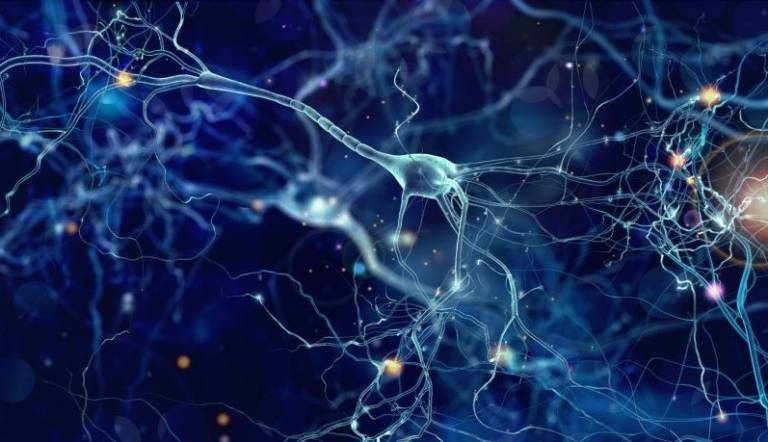Scientists discover how neurons die in Alzheimer’s disease
19 September 2023
A team of researchers led by Professor Bart De Strooper (UK Dementia Research Institute at UCL, and VIB-KU Leuven) and Dr Sriram Balusu (VIB-KU Leuven) have discovered how neurons die in Alzheimer’s disease.

The breakthrough study, published in Science, illustrates how neurons initiate a programmed form of cell death, known as necroptosis, when they are exposed to amyloid plaques and tau tangles – the hallmark misfolded proteins implicated in Alzheimer’s disease.
Crucially, the research team were also able to prevent the death of neurons and rescue them in the process. This discovery opens new pathways for potential future treatments.
Alzheimer’s disease is one of the most common forms of dementia, accounting for 60% to 70% of dementia diagnoses. Each year, between six and seven million patients are diagnosed with Alzheimer’s. As a debilitating disease that often comes with major emotional and psychological burden for patients and their families, it represents a growing societal challenge and has been classified as a public health priority by the World Health Organisation (WHO).
Even though there have been recent developments in treatments that slow down disease progression, there is currently no cure for Alzheimer’s disease as the underlying cause is still not fully understood.
The new research reveals some of the biological mechanisms underpinning the disease.
Professor Bart De Strooper, said: “Our study sheds light on the previously murky waters of Alzheimer’s disease, revealing a potential key player in neuronal loss – an RNA gene called MEG3, and the process of necroptosis.
“These findings are an important step forward in furthering our understanding of the basic mechanisms underlying this complex and often misunderstood disease.”
One of the key challenges in understanding Alzheimer’s disease has been connecting its defining hallmarks – amyloid plaques, tau tangles, and death of neurons – to each other.
Most mouse models used in research couldn’t naturally replicate these features, leaving scientists with unanswered questions about how they relate to disease progression.
First author, Dr Sriram Balusu, said: “To bridge this gap, we created a new model. We implanted both healthy human and mouse neurons into the brains of AD mouse models. The human cells degenerated much like their counterparts in the human brain, allowing us to study them during brain ageing and shine a new light on the processes underlying Alzheimer’s disease.”
Remarkably, only the human neurons, and not their rodent counterparts, displayed features of Alzheimer’s disease seen in the brains of patients, including tau tangles, and significant neuronal cell loss. This suggests that there may be human-specific factors at play in Alzheimer’s disease that standard mouse models can’t replicate.
Understanding why mouse neurons are more resilient to amyloid pathology will not only help model the disease better but might also stimulate research into pathways that protect against neurodegeneration.
Using their new model, the team probed deeper, seeking answers on how neurons die in Alzheimer’s disease. The study revealed that a pathway known as necroptosis – a form of programmed cell death – was activated in the model, leading to death of neurons.
Additionally, researchers found that levels of a molecule known as MEG3 were strongly increased in human neurons, as seen in Alzheimer’s patients. Strikingly, just the presence of MEG3 alone was enough to trigger the pathway of necroptosis in human neurons in a lab setting.
The study also found that by reducing MEG3 and preventing necroptosis, researchers could prevent the death of cells.
More research is needed to understand how exactly MEG3 triggers necroptosis, but this discovery represents a crucial advancement in understanding how Alzheimer’s leads to the loss of neurons in the brain.
Professor De Strooper, said: “Necroptosis is already an active area of drug development in cancer and ALS. While there’s much more to explore, our findings open up promising avenues for potential therapies targeting Alzheimer’s disease, alongside traditional approaches aimed at amyloid and tau.”
Links
- Professor Bart De Strooper's academic profile
- UK Dementia Research Institute at UCL
- UCL Brain Sciences
Image
- Credit: whitehoune on iStock
Media contact
Poppy Danby
E: p.danby [at] ucl.ac.uk
 Close
Close

